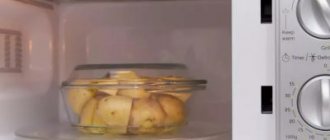Potatoes are one of the most frequent guests on our table. To eat quality vegetables all year round, it is important to preserve them properly. The harvest is kept not only in the cellar, but also in the apartment: the corridor, pantry, on the balcony, kitchen and in the refrigerator.
To prevent the tubers from rotting and starting to germinate, they are provided with optimal conditions: temperature, humidity level and air circulation.
Timing for harvesting potatoes for winter storage
Only ripened tubers are stored well . The signal for harvesting is the drying of the leaves. Experienced summer residents wait about a month until the tops are completely dry. Only dig up vegetables in sunny, dry weather to reduce the risk of rotting in the future.
Early varieties are harvested in late July - early August, mid-season varieties - until the end of summer, late varieties - from late August to the first weeks of September.
Preparation for storage
Preparing potatoes is extremely important and consists of several stages :
- The dug up tubers are placed on a polyethylene flooring in one layer in the open air and dried for about a day. This will rid the supplies of microorganisms and remove excess moisture.
- The potatoes are finally cleared of soil and sorted. Separate specimens with mold, signs of insects, or mechanical damage from healthy tubers. Vegetables are also sorted by variety to take into account shelf life. Early crops are used first.
- The harvest is placed on film under a canopy and left to dry for another day.
After this, the vegetables are placed in boxes or bags for winter storage .
How to store vegetables and fruits in the kitchen?
There is a certain set of rules under which fresh vegetables and fruits are stored the longest. Many of them are understandable to housewives on an intuitive level, from past experience of living with grandparents, mothers and fathers.
All vegetables can be divided into two groups: above-ground and “underground” (root vegetables). Ground vegetables are best stored in the refrigerator. Modern models have special “freshness zones” and fresh boxes in which herbs, vegetables, and fruits retain their taste and aroma for months. But for storing root vegetables, it is enough to provide a cool and dark place in cabinets and cabinets in the kitchen. In this case, you first need to sort out, dry and carefully cut off the tops.
Optimal conditions
To ensure that potatoes are edible for as long as possible, the following conditions must be observed::
- check that pests (rats, mice, insects) do not enter the storage;
- create an optimal microclimate (+2...+4°C, 75–80% humidity);
- for storage choose wooden boxes with flooring, nets or canvas bags;
- sort the tubers once every 1–1.5 months.
Storing in the refrigerator or freezer
Although storing potatoes in the refrigerator is convenient and easy, it will not be possible to fit the entire crop on the shelves. In addition, low temperatures and condensation can have a detrimental effect on the taste of tubers.
How long
The shelf life of potatoes in the refrigerator is short, 5–10 days . Therefore, it is better to place vegetables in small batches, 2-3 kg each. This amount is eaten in about 1.5 weeks.
in the freezer for 10-15 days, prepared whole or in strips - 3-6 months.
In any form
Raw potatoes are kept on special vegetable shelves for a week . The tubers are first checked for damage and cleared of soil.
Peeled vegetables quickly darken when exposed to air.
To keep the product fresh longer, do the following :
- The tubers are washed and then placed in a container with cold water. At room temperature, this will increase the shelf life of potatoes by 4 hours, in the refrigerator - by a day.
- Vegetables are washed and thoroughly dried with paper towels, placed in vacuum bags, tightly sealed and placed in the freezer.
The shelf life of boiled potatoes in the refrigerator is 3-4 days.
Important! The vegetable cannot be stored as part of other dishes for more than 2 days.
Why not
Although cold is the main assistant when storing food, it is destructive for long-term storage of potatoes :
- at low temperatures, starch turns into glucose and gives potatoes a sweetish taste;
- Condensation formed due to warm air causes vegetables to become damp and begin to rot.
How best to store
In the refrigerator, the tubers are kept on the bottom shelf for vegetables at a temperature of +5°C ; boiled, fried and raw potatoes are stored in the freezer. Before being placed in the chamber, the vegetables are blanched, dipped in boiling water, and then in ice water, dried with paper towels and placed in containers.
By the way! To freeze fried potatoes, cool them completely and remove excess fat with napkins.
Storing vegetables in the kitchen: ideas and options for shelving, drawers, baskets and other storage systems
A thrifty housewife always has food supplies in the kitchen. Vegetables and fruits are no exception. Some of them are stored in the refrigerator freezer or freezer in the form of blanks, some are rolled up in compotes and various preserves. But still, most of it is needed fresh for cooking. And this requires well-thought-out storage of vegetables in the kitchen. You can equip your kitchen cabinet or cabinet with special containers and baskets. Or build a separate rack, purchase a special shelf with drawers - there are a lot of options and solutions.
How to store potatoes in an apartment
In the absence of a cellar, the harvest is kept until spring at home.
In the corridor
Although storing potatoes in an apartment allows you to always have access to the crop, it is complicated by some problems.
The temperature in the corridor is constantly changing, supplies suffer from the cold air that is let in when the door is opened. Vegetables are threatened by dirt and water from shoes and umbrellas.
In such conditions, the optimal humidity level (75–80%) is monitored . To prevent the tubers from fogging up and to keep them clean, they are covered with burlap. If the apartment is hot, place a container of water next to the crop.
At the entrance
The entrance of an apartment building allows you to store large volumes of potatoes , but the first danger of such conditions is the people living nearby. To prevent anyone from stealing supplies, the box with them is locked and secured to the floor.
Important! In winter, emergency situations often arise at the entrance: sewerage leaks, pipes burst. This negatively affects the quality of the tubers.
At room temperature
Room temperature is not suitable for long-term storage of potatoes : it is much higher than the optimal +2..+4°C, so the tubers rot, dry out or sprout. The shelf life of vegetables in such conditions is 10–14 days.
In the pantry
How to store potatoes in an apartment for the winter? A storage room is the best option : a constant climate is maintained here and the sun’s rays do not enter the room.
Tubers do not germinate, do not turn green and do not rot . Keep the harvest in wooden boxes with holes or nets for sufficient air circulation.
If the air in the pantry is too dry, increase the humidity to 75–80% with a spray bottle , a damp cloth, or an open bottle of water left in the room.
In the kitchen
Due to the small kitchen area, vegetables are often kept under the sink. The main advantage of this method is that the potatoes will be in close proximity to the cooking area . However, if the plumbing is faulty and condensation accumulates under the sink, the tubers will quickly rot. Pests also spoil the crop.
Important! The space under the sink should be well ventilated.
Vegetables are placed in wicker baskets or wooden boxes with holes.
On the balcony
The balcony is a common place to store potatoes at home. Large boxes of vegetables are placed here, and the relatively constant temperature allows the tubers to remain fresh until spring.
Choosing a balcony
Even on a glazed balcony it is often cold in winter , especially during January frosts, so a heated room is better suited.
The presence of temperature sensors will help create an optimal microclimate for the tubers (+2…+4°C). It is impossible to create suitable conditions for the harvest on an open balcony without special tools and containers - the tubers will be affected by cold weather, so preference is given to a glazed space.
How long do potatoes last?
At suitable temperature, humidity and air circulation on the balcony, the tubers will remain fresh until spring.
If such conditions are not created, the potatoes will last about 1-2 months, until the first autumn showers.
The best ideas for storing vegetables in the kitchen
There are actually a lot of options for arranging special storage spaces for vegetables, ideas and rather original implementations. Many storage systems can be made with your own hands or purchased ready-made. The choice of one solution or another depends on whether you asked this question at the kitchen planning stage or whether the need arose after the kitchen space had been completely arranged. In the first case, you can make separate drawers, cabinets and cabinets for storing vegetables in the kitchen unit itself. In the second, look for containers, shelves and racks of suitable size to be built into free niches and corners in the kitchen.
Shelves and racks for storing vegetables
A plastic mobile shelf, rack or chest of drawers is an excellent option for storing vegetables. Such a piece of furniture can be “rolled” under the table: it will not interfere and somehow “give away” its presence.
Shelves for storing vegetables with built-in plastic baskets are convenient and spacious. At the same time, they are easy to clean, which is important.
You can make a wooden rack for storing vegetables with your own hands in the required sizes. You can use any available material - remnants of timber, wooden boxes for vegetables and berries, seedlings and flowers.
A practical and more expensive option is metal chests of drawers with mesh drawers-baskets from the wardrobe systems of Ikea, Aristo, Elfa and others. They can also be adapted for storing vegetables in the kitchen and purchased in the required configuration and suitable sizes.
Boxes and containers for storing vegetables in the kitchen
Housewives whose kitchen is combined with a loggia or balcony are in a more advantageous position. There you can always allocate space for installing a box for storing vegetables. Or come up with additional racks to place containers on them.
A built-in cabinet on the loggia with shelves for canning and drawers for storing vegetables is a great idea that you can implement with your own hands.
Lightweight shelving structures and chests of drawers for storing vegetables can be narrow or wide, ideal for embedding into a specific free space.
Ordinary plastic buckets can also be used as boxes and containers. It is better to opt for square models - they are more spacious and “fit” into cabinets without taking up extra space.
How to organize vegetable storage under the sink and in kitchen cabinets
Modern kitchens are made on adjustable legs with a height of 100-150mm. The space between them often remains empty. But it can be used to store vegetables!
Drawers are more convenient. But you can simply purchase low containers of the desired size and simply place them behind the plinth.
The space in the sink cabinet is traditionally empty - some people put a trash can there, others store household chemicals. Or maybe vegetables! In special pull-out storage systems or simple plastic boxes with perforations that can be stacked on top of each other.
How to extend storage
To keep potatoes fresh until spring, a number of conditions must be observed.:
- Maintain the temperature at +2..+4°C. At higher rates, vegetables will begin to sprout; at lower rates, they will freeze.
- Provide air humidity of 70–85%. This will prevent the tubers from rotting.
- Choose a room with good ventilation.
- They isolate the crop from exposure to light: due to direct sunlight, potatoes produce a toxic substance - solanine. Green tubers are immediately disposed of.
- The bottom of the storage is covered with sand. It will absorb excess moisture and prevent vegetables from rotting.
How to keep potatoes
How to properly store potatoes in an apartment? Depending on the conditions, vegetables are kept in boxes or mesh bags .
In wooden boxes
Boxes without heating are kept in an apartment, basement or on a glazed heated balcony . Such containers will provide the necessary ventilation, and the tree will not allow the tubers to become damp.
The box can be put together from scrap boards, old furniture, or purchased ready-made.
Healthy! Sometimes the container is insulated with polystyrene foam, foil or warm cloth, tightly closing all holes. This will protect the crop from cold snaps, but will reduce ventilation. To prevent vegetables from getting damp, they are sorted regularly.
For vegetables they sell special boxes with automatic temperature control . They are more expensive and require some work skills, but they are guaranteed to save supplies until spring.
In plastic boxes
Such containers are available and inexpensive, but do not contain holes for ventilation. Plastic is an artificial material that does not allow air or moisture to pass through , which creates a greenhouse effect.
To eliminate this drawback, make small holes in the walls of the box , pour sand or put hay on the bottom.
Important! Such containers are not suitable for use on the street or in the entrance.
other methods
When storing in a warm barn or pantry, use regular nets.
(thermal containers) of different sizes, equipped with foil insulation on the inside, are suitable for balconies This device is quite compact and allows you to store vegetables for a long time. Models are sold with temperature sensors and heating elements that will raise the temperature inside the backpack if supplies are kept on an unheated balcony.
Storage systems for vegetables and fruits in separate cabinets and kitchen cabinets
If it is possible to allocate a separate cabinet for storing vegetables in the kitchen, then this idea can be implemented in different ways.
The first option for storing vegetables in the kitchen is built-in mesh baskets with a pull-out mechanism. Both single-level and multi-level configurations can be used.
The idea of using retractable kitchen bins, which are designed to sort garbage and are built into drawers, is also quite successful.
It is cheaper to use ordinary plastic baskets and containers for storing vegetables, also equipping them with guides so that they can be pulled out from the cabinet body.
Common Mistakes
When storing potatoes at home and on the balcony, the following mistakes are made :
- The tubers are not sorted carefully enough. It is important to get rid of damaged specimens and use only whole and healthy ones.
- Keep potatoes together with other vegetables. The ideal neighbor for a vegetable is beets; they are laid out as a top layer to absorb excess moisture.
- Containers are not disinfected. To preserve the harvest, it is recommended to treat boxes and bags with a solution of potassium permanganate.
How to prepare the harvest for planting
Careful preparation is the main secret to storing potatoes for a long time. The “correct” technology includes several stages. Let's look at each of them.
Variety selection
When purchasing or before planting, it is important to choose the right variety. Only late or mid-late varieties are suitable for long-term storage. Mid-early or early ones please with rapid ripening, but they will last no more than a month or two. When grown independently, it is easier to influence the keeping quality of the future harvest. For example, overfeeding with nitrogen fertilizers reduces disease resistance. This factor must be excluded. When buying on the market, all you have to do is trust the seller and choose carefully.











